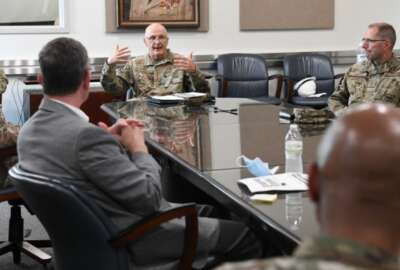

Hubbard Radio Washington DC, LLC. All rights reserved. This website is not intended for users located within the European Economic Area.
The Air Force's top acquisition official said reforms that were initiated long before a pandemic was on the horizon went a long way toward dealing with the curr...
This past spring, when Air Force contracting officials first started poring over employment and other data indicating how the COVID-19 pandemic was hitting the defense industrial base, it wasn’t a pretty picture. And it quickly became apparent that time was of the essence.
But even with the overwhelming majority of the contracting workforce still figuring out how to do their jobs in a telework environment, the service managed to quickly accelerate $3.9 billion in already-planned contracts, in addition to executing billions in new funding Congress had just appropriated as part of the CARES Act.
Various short-term policy waivers the Air Force and DoD made in response to the pandemic certainly helped. But according to the service’s top contracting official, a bigger factor in letting the workforce move quickly was a series of organizational and cultural changes the Air Force made before it knew a pandemic was coming – mostly motivated by the need to prepare the acquisition bureaucracy for the agility needed for “great power” competition with China and Russia.
“The first thing I did was to get together a threat briefing that I could take to every man, woman and child in Air Force contracting, and for an hour, I would take them through a classified briefing of how serious this threat is,” Maj. Gen. Cameron Holt, the deputy assistant secretary of the Air Force for Contracting said in a wide-ranging interview for Federal News Network’s On DoD about lessons learned from the pandemic. “I think if you really respect the people that work for you, you’ll go out of your way to explain the ‘why’ before you explain before you explain the ‘what.’”
Also prior to the pandemic, the Air Force’s contracting community had just gone through an initiative called Operation Clean Sweep. The objective was to eliminate as many unnecessary acquisition rules as possible — particularly ones that slowed the system down without creating any clear benefit.
Simultaneously, Holt says he delegated acquisition decisions to lower levels of the Air Force and Space Force. Members of a new Air Force Contracting Board of Directors were given the authority to approve contracts of up to $1 billion within their own portfolios, and individual contracting officers were given up to a ten-fold increase in the contracts they could sign without seeking higher-level approval.
And although historically, changes in centralization and decentralization of authority have tended to be cyclical within the Defense acquisition system, Holt said he believes these changes stand a better chance of lasting over time.
“When you do it for show, it’s very simple to push authority down and sound very innovative and forward-leaning. But if you really want it to endure, it’s a lot of hard work,” he said. “You’ve got to write it down, and you’ve got to be willing to burn what you’re not going to use anymore. I joke around with my folks that I’m Cortés and I am burning the ships behind us. So in Operation Clean Sweep, for example, not only did we delete hundreds of pages of useless mandatory procedures that really served to just stop people from thinking and sucked all the authority and innovation out of the room, we streamlined and simplified what remained.”
When it came time to apply that more streamlined system to the pandemic, the Air Force had two challenges. As the government’s executive agent for the Defense Production Act, it had a lead role in not just applying the DPA toward propping up teetering elements of the defense industrial base, but also in helping the Department of Health and Human Services acquire critical medical supplies.
Holt said the Air Force and DoD have fairly robust tools to monitor the health of companies in the Defense supply chain. But the health care industry was a big blind spot.
One example was the need to quickly ramp up production of the nasal swabs needed to conduct coronavirus testing. Puritan Medical Products, a fairly-small company in Maine, was the nation’s leading supplier to the health care industry. But when the government first approached the firm, its executives saw no clear way they could ramp up production at the scale and on the timeline federal officials were asking for.
Holt said the Air Force’s DPA experts knew nothing about cotton swab manufacturing capacity. But they knew a lot about Bath Iron Works, a major shipbuilding company a couple of hours down the road from Puritan’s facility.
“We knew what their capabilities were, we knew what they were good at,” he said. “So we asked Bath Iron Works’ leadership if they would partner with us and with Puritan to help them rapidly stand up machine tools and the plant and equipment necessary. They said, ‘Absolutely, we’re in,’ and they and their supply base set up all those machine tools to rapidly start churning out a high number of nasal swabs. It was incredible to watch.”
Congress, the Pentagon’s office of Defense Pricing and Contracting and the Air Force itself have all issued short-term acquisition policy changes in response to the pandemic. Holt said that’s let his department run the pandemic response in much the same way it handles contingency contracting during wartime.
“That basically brought all of the flexibilities we would exercise on a battlefield into the continental United States,” he said. “It was really critical, because we had to move really fast to save some industries and some companies that were immediately impacted by the rapid downturn of commercial air traffic, commercial aircraft orders, engine orders, and on and on. We sent out a number of policy memos that were nothing more than encouraging contracting officers and program managers to lean forward to exercise every authority at their disposal.”
But there’s a flip side to that coin. If the pandemic showed that the Defense acquisition system truly can move quickly when it must, for Holt, it’s also a reminder that the system is needlessly complex when there’s not an immediate emergency at hand.
“The documentation requirements in our Cold War acquisition and contracting system is still something that you have to deal with, even if it’s after the fact, in a contingency environment. And we really have to start understanding that the world has changed since the 1980s,” he said. “Eighty percent of the R&D spending in America is not defense, it’s commercial. If we’re going to harness that kind of innovation, we’re going to have to start doing business like they do. We’re going to need authorities from Congress to act with just good judgment, and not in the paradigm of a 1980s government setting.”
Part of that, he said, is changing the way Congress appropriates funding for Defense acquisition programs. As of now, DoD budgets are built several years in advance, with high degrees of specificity as to which particular programs, projects and activities the funding can be spent on once they’re eventually approved by lawmakers.
“We have got to figure out a way to allow Congress to oversee us without the use of subdivided appropriations down to the gnat’s eyelash,” he said. “We’re going to have to provide more funding flexibility in broad portfolios and capabilities, and allow for more fungibility between what we invest in in the year of execution. The idea of appropriating a certain dollar for a certain program with a certain contractor immediately destroys our monopsomistic advantage, and it limits the flexibility to such a degree that we can’t compete with China or Russia in terms of the speed of decision making that is necessary. These are the things I’d love to have real serious conversations about with the staffers on the Hill — not to avoid oversight, but to reinvent oversight.”
Copyright © 2024 Federal News Network. All rights reserved. This website is not intended for users located within the European Economic Area.
Jared Serbu is deputy editor of Federal News Network and reports on the Defense Department’s contracting, legislative, workforce and IT issues.
Follow @jserbuWFED


